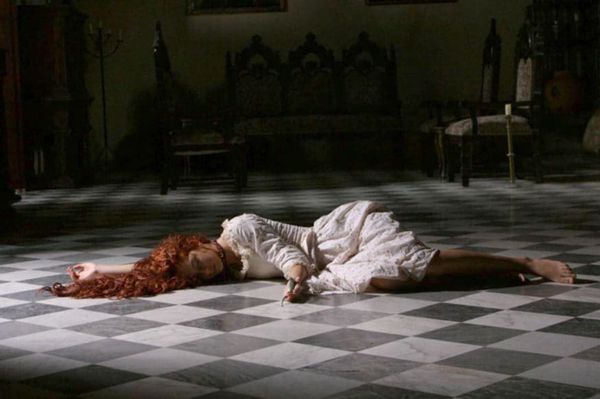Eye For Film >> Movies >> Of Love And Other Demons (2009) Film Review
Of Love And Other Demons
Reviewed by: Jennie Kermode

In adapting a novel for the screen, a writer is often faced with a stark choice - to adhere to the literal narrative, or to adhere to the spirit of it. In adapting the work of Gabriel García Márquez, there can only be one way to go. The spirit is the narrative and only a poetic interpretation can hope to capture its substance. Of Love And Other Demons is such a film.
In an extraordinarily confident début, writer/director Hilda Hidalgo gives us imagery to match that in García Márquez's own prose. True, the visual aspects of the story are well defined - the darkness of the dungeon, the blue of the sea, and the extraordinary copper-coloured hair of the young heroine - but it's the manner in which Hidalgo brings them together, her langourous pacing and her sumptuous framing of shots that helps to make this one of the best adaptations of the author's work to date. Picture Sierva, 12 years old, standing before a window with a beautiful blue green lizard crawling across the back of her hand. Around her neck are long strings of beads, inspired by the African nanny she loved. "Do, when you die I shall die too," she has promised. Soon she will be bitten by a rabid dog, locked up in the basement of a convent, considered possessed.

As Sierva, Eliza Triana is remarkable for her stillness. True, there are outbursts of fury, but much of the time she seems as if she is already far away; hers is an otherworldly beauty, just as her character is a product of imported traditions that sit ill at ease with the respected religious customs of 17th century Colombia. But this story is not hers alone. Rather, her presence forms the crux of an emotional and spiritual journey that will tear a young priest away from his church and everything he has tried to believe, driving him toward destruction.
It's a simple story; in the past it has successfully been adapted as an opera. The devil is in the details. Does Sierva really have rabies; and if she does not, is there something else within her that is every bit as infectious, as deadly? Is it her, or is it the tormented priest's own pursuit of knowledge that draws him to an understanding of the world which cannot be reconciled with survival? In cautioning him away from knowledge and toward faith, is his master trying to protect the church hierarchy or genuinely offering wisdom; and if the latter, for what reason does he confront him with such temptation? There are many difficult questions hidden below the surface of this seemingly straightforward love story, and Hidalgo seems adept at finding them.
Dalmatian-spotted moths. A candle dropped into a well. A solar eclipse. "The only problem with your eyes," the doctor tells the priest, "is that they see too much." Pablo Derqui plays the priest, a patch over one eye; his performance is at once intense and carefully mannered as he moves from one tableau to another, each recalling the oil paintings of the period, a distinct Cartagena tradition. Nobody in this film seems to breathe without instruction, without meaning. It is a film you should watch when you are fevered. It is a film you should watch when the weather is unbearably hot. It is art and folklore and scripture, a remarkable accomplishment.
Reviewed on: 21 Feb 2011















